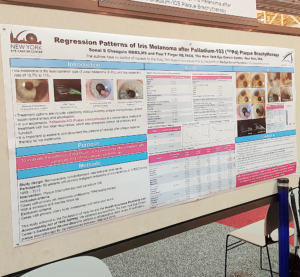Preserving Sight: Palladium-103 Radiation Therapy Saved This Patient’s Only Functioning Eye
October 2018–––In a recent publication in Cornea: The Journal of Cornea and External Disease, a noteworthy case report describes a patient with squamous cell carcinoma (SCC) in his only functioning eye who had his vision saved using a remarkable application of palladium-103 plaque radiation therapy.
Of all subtypes of conjunctival and corneal cancer, SCC is the most prevalent. The most common treatment for this type of superficial tumor is chemotherapy eye drops. However, in this particularly unique case, a functionally monocular patient presented with invasion of squamous cell cancer through a corneal wound into his eye. Maintenance of vision was essential for this patient, as he could only see using the affected eye.
Thus, a complex decision had to be made. Dr. Finger noted:
“Though we can treat even giant squamous carcinomas of the conjunctiva with topical chemotherapy eye drops, there is no evidence to support their use for intraocular tumor invasions. It is my opinion that it was unlikely that chemotherapy eye drops would penetrate deep enough into the eye to cure this patient.”
This was the potentially vision-saving observation. Since the SCC had spread internally, topical treatment was unlikely to reach the tumor. Had this treatment been chosen as a conservative intervention, the patient might have lost total vision and/or the entire eye.
In an effort to treat the tumor with minimum damage to the eye, palladium-103 plaque radiation therapy was chosen as an eye and vision-saving solution to the patient’s particular case. Such would simultaneously save the patient’s sight and their life.
According to the article, surgery was performed in June of 2014. Nearly 4 years later, the tumor has regressed without recurrence, and his vision is the same as before the radiation.
Thus, even in the face of the most unique cases, palladium-103 radiation therapy has proved remarkably effective.
For more information read the full case report here: [link]
The New York Eye and Ear Infirmary of Mt. Sinai Ocular Oncology Service [link]
About Paul T. Finger, MD [link]













